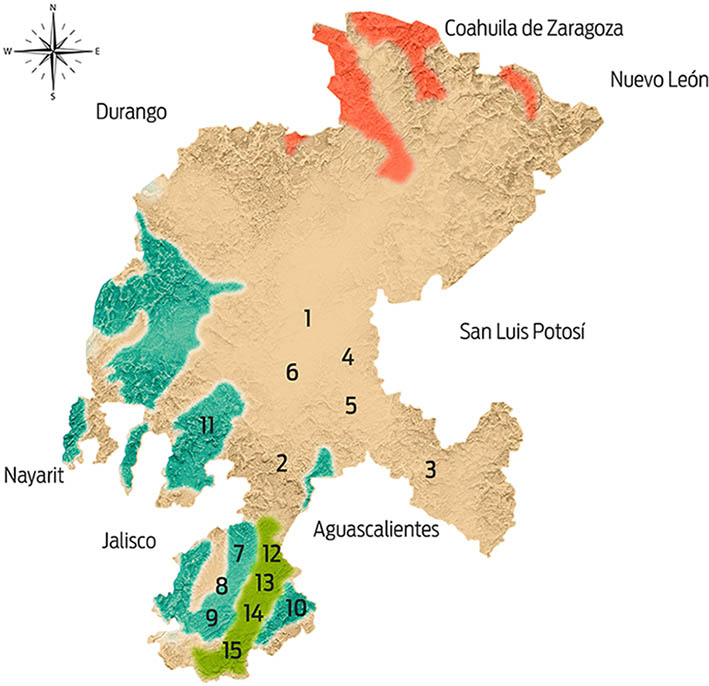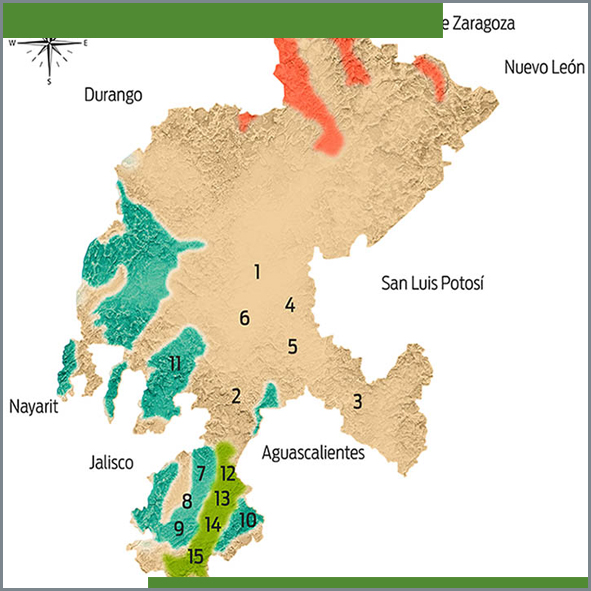Africanization of honey bees (Apis mellifera) in three climatic regions of northern Mexico
Main Article Content
Abstract
Veterinaria México OA
ISSN: 2448-6760
Cite this as:
- Medina Flores CA, Guzmán Novoa E, Hamiduzzaman MM, Aguilera Soto J, López Carlos MA. Africanization of honey bees (Apis mellifera) in three climatic regions of northern Mexico. Veterinaria México OA. 2015;2(4). doi: 10.21753/vmoa.2.4.353
This study was conducted to analyze the process of Africanization of managed honey bee (Apis mellifera) colonies by determining the frequency of African and European morphotypes and mitotypes (mtDNA) in three different ecological environments of northern Mexico. Colonies (n= 151) were sampled in 1) temperate semi-dry; 2) semi-warm semi-dry; and 3) temperate sub-humid regions in the state of Zacatecas. The mtDNA type was determined by PCR-RFLP and the morphotype by the Fast Africanized Bee Identification System (FABIS). Out of all the colonies sampled in all areas, the mtDNA analysis showed a significantly higher frequency of European maternal lineage (77.5%) than of African maternal lineage (22.5%; P <0.0001). The morphometric analysis classified 47% of the colonies as European and 42.4% of them as Africanized. The frequency of colonies with African or European mitotypes and morphotypes varied significantly between regions (P <0.05) with results indicating a higher degree of Africanization in the semi-warm semi-dry region. Conversely, the highest frequency of colonies with the European morphotype and mitotype occurred in the temperate semi-dry region. These results suggest that the environment affects the degree of Africanization of honey bee colonies in northern Mexico. Colonies established at higher altitudes and in more temperate climates have more European genotypes than colonies established in tropical regions. Several hypotheses are discussed to explain these results.

Article Details
References
Clarke KE, Rinderer TE, Franck P, Quezada-Euán JJG, Oldroyd BP. 2002. The Africanization of honey bees (Apis mellifera L.) of the Yucatan: a study of a massive hybridization event across time. Evolution, 56(7):1462-1474. DOI: 10.1111/j.0014-3820.2002.tb01458.x
Danka RG, Hellmich RL, Rinderer TE. 1992. Nest usurpation, supersedure and colony failure contribute to Africanization of commercially managed European honey bees in Venezuela. Journal of Apicultural Research, 31(3-4):119-123.
Domínguez-Ayala R, Moo-Valle H, May-Itzá WDJ, Medina-Peralta S, Quezada-Euán JJG. 2015. Stock composition of northern neotropical honey bees: mitotype and morphotype diversity in Mexico (Hymenoptera: Apidae). Apidologie, 1-11. DOI: 10.1007/s13592-015-0414-6
Guzmán-Novoa E, Uribe RJL. 2004. Honey production by european, africanized and hybrid honey bee (Apis mellifera) colonies in Mexico. American Bee Journal, 144:318-320.
Guzmán-Novoa E, Correa-Benítez A, Guzmán G, Espinosa LG. 2011. History, colonization and impact of the africanized honey bee in Mexico. Veterinaria México, 42(2):149-178.
Hall GH. 1992. DNA studies reveal processes involved in the spread of New World African Honeybees. Florida Entomologist, 75(1):51-59. DOI:10.2307/3495480
[INEGI] Instituto Nacional de Estadística Geografía e Informática. 2005. Municipios de Zacatecas, pp. 234-235.
Kerr WE. 1967. The history of the introduction of African bees to Brazil. South African Bee Journal, 39:3-5.
Nielsen DI, Ebert PR, Page RE Jr, Hunt GJ, Guzmán-Novoa E. 2000. Improved polymerase chain reaction-based mitochondrial genotype assay for identification of the africanized honey bee (Hymenoptera: Apidae). Annals of the Entomological Society of America, 93(1):1-6.
Nogueira-Neto P. 1964. The spread of a fierce African bee in Brazil. Bee World, 45(3):119-121.
Otis GW. 1991. Population biology of the africanized honey bee. In: Spivak M, Fletcher D, Breed M. The African Honey Bee. Boulder, Colorado, USA: Westview Press, pp. 213-234.
Pinto AM, Rubink WL, Patton JC, Coulson RN, Johnston JS. 2005. Africanization in the United States: replacement of feral european honey bees (Apis mellifera L.) by an african hybrid swarm. Genetics, 170:1653-1665.
Quezada-Euán JJG. 2000. Hybridization between european and africanized honeybees in tropical Yucatan, Mexico. II. Morphometric, allozymic and mitochondrial DNA variability in feral colonies. Apidologie, 31(3):443-454. DOI:10.1051/apido:2003010
Quezada-Euán JJG. 2007. A retrospective history of the expansion of africanized honeybees in México. Journal of Apicultural Research and Bee World, 46(4):295-300. DOI: 10.1080/00218839.2007.11101412
Quezada-Euán JJG, Medina LM. 1998. Hybridization between european and africanized honeybees (Apis mellifera L.) in tropical Yucatan, Mexico. I. Morphometric changes in feral and managed colonies. Apidologie, 29(6):555-568
Rinderer TE, Hellmich RL. 1991. The processes of africanization. In: Spivak M, Fletcher D, Breed M. The African Honey Bee. Boulder, Colorado, USA: Westview Press, pp. 373-398.
Rinderer TE, Oldroyd BP, Sheppard WS. 1993. Africanized bees in the U.S. Scientific American, 269:52-58.
[SAGARPA] Secretaría de Agricultura, Ganadería, Desarrollo Rural, Pesca y Alimentación. Servicio de información y estadística agroalimentaria (SIAP). 2005. http://www.siap.sagarpa.gob.mx [access: 14 jul 2011].
SAS Institute. 2002. Statistical software Ver. 9.0. [en línea] Cary, North Carolina, USA.
Schneider SS, DeGrandi-Hoffman G, Smith DR. 2004. The african honey bee: factors contributing to a successful biological invasion. Annual Review Entomology, 49(1):351-376. DOI: 10.1146/annurev.ento.49.061802.123359
Smith DR. 1991. African bees in the Americas: insights from biogeography and genetics. Trends in Ecology and Evolution, 6(1):17-21.
Sylvester HA, Rinderer TE. 1987. Fast Africanized Bee Identification System (FABIS) Manual. American Bee Journal, 127(7):511-516.
Taylor OR. 1977. The past and possible future spread of africanized honey bees in the Americas. Bee World, 58:19-30.
Uribe RJL, Guzmán-Novoa E, Hunt GJ, Correa BA, Zozaya RJA. 2003. Efecto de la africanización sobre la producción de miel, comportamiento defensivo y tamaño de las abejas melíferas (Apis mellifera L.) en el altiplano mexicano. Veterinaria México, 34(1):47-59.
Whitfield CW, Behura SK, Berlocher SH, Clark AG, Johnston JS, Sheppard WS, Smith DR, Suarez AV, Weaver D, Tsutsui ND. 2006. Thrice out of Africa: ancient and recent expansions of the honey bee, Apis mellifera. Science, 314(5799):642-645.
Zamora O, Domínguez R, Alaníz-Gutiérrez L, Quezada-Euán JJG. 2008. Frequency of european and african-derived morphotypes and haplotypes in colonies of honey bees (Apis mellifera) from NW México. Apidologie, 39(4):388-396. DOI: 10.1051/apido:2008016
License

Veterinaria México OA by Facultad de Medicina Veterinaria y Zootecnia - Universidad Nacional Autónoma de México is licensed under a Creative Commons Attribution 4.0 International Licence.
Based on a work at http://www.revistas.unam.mx
- All articles in Veterinaria México OA re published under the Creative Commons Attribution 4.0 Unported (CC-BY 4.0). With this license, authors retain copyright but allow any user to share, copy, distribute, transmit, adapt and make commercial use of the work, without needing to provide additional permission as long as appropriate attribution is made to the original author or source.
- By using this license, all Veterinaria México OAarticles meet or exceed all funder and institutional requirements for being considered Open Access.
- Authors cannot use copyrighted material within their article unless that material has also been made available under a similarly liberal license.



